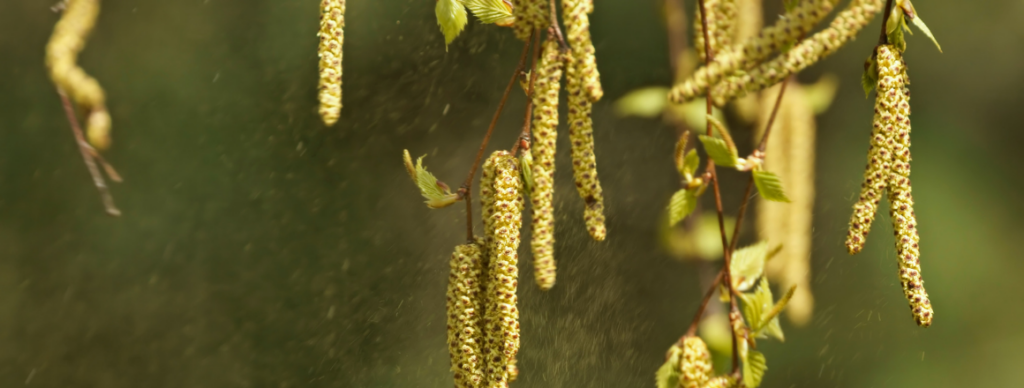Spring allergies are on the rise as symptoms worsen among society.
All Americans look forward to spring, especially New Englanders, as the promise of walks on warm days and taking aesthetic photos of flowers blooming by sidewalks help us make it through winter. Every year in the United States, however, nearly one in three adults and over a quarter of children fall victim to the runny noses and watery eyes triggered by pollen, a seasonal supervillain (1). With each passing year, spring allergy season seems to worsen, with more sinuses succumbing to the weather. What could possibly be causing this?
To answer this question, we must first look into what causes these allergies. All seasons come with allergies that affect many. These allergies come in the form of common symptoms such as runny eyes and noses, sneezing, and coughing. When someone comes into contact with allergens, such as spring pollen, their immune system releases chemicals like histamines, leukotrienes, and prostaglandins (2). Cells throughout the body, called Mast cells, alert the immune system that there is an infection inside the person’s body and release these chemicals to attack the allergen (3). More specifically, when a person with pollen allergies inhales pollen, it gets stuck in mucus membranes inside their nasal passages, causing inflammation in their nose and eyes (2). The cause of inflammation in your nasal passages, also known as allergic rhinitis, is the sinuses attempting to flush out the pollen particles. Birch and oak trees, along with grass, are the main producers of these culprits that make people sick. When the trees bloom during springtime, they release pollen that gets scattered into the atmosphere by wind. One birch tree alone, for example, can produce 5.5 million grams of pollen (4)!

In 2021, the World Climate Research Programme published a study, showing that pollen season started 20 days earlier and had 21% more pollen than it did in 1990. According to William Andregg, a researcher for the World Climate Research Programme, this increase is probably due “to a mixture of somewhat bigger plants and somewhat more pollen production per flower.” The increased pollen production in pollinator plants due to climate change is linked to the biological process of photosynthesis. Elevated levels of carbon dioxide (CO₂) resulting from climate change stimulate photosynthesis, leading to greater plant growth and reproduction. This surplus of sustenance encourages pollinator plants to produce more pollen as part of their natural reproduction process. Climate change also brings warmer temperatures, which signals plants to bloom earlier and means a longer allergy season (5). Levels of precipitation have also increased due to the warming climate. Larger amounts of rain and more humidity cause pollen spores to swell and eventually rupture, breaking down into smaller pieces that are more easily dispersed in the air and penetrate deeper into people’s lungs. Consequently, individuals may experience heightened respiratory reactions as the fragmented pollen particles reach sensitive tissues in the lungs and sinuses more easily. The mix of air pollutants from fossil fuels and pollen makes the effect of allergies on people’s health more severe and can be deadly for those who are also affected by conditions like asthma (6). Americans are not the only people affected by pollen allergies. As temperatures are rising globally, more countries are also faced with warmer spring weather that stimulates the growth of pollinating plants (7).
Climate change affects everyone, even animals, as natural habitats are destroyed and coastal cities disappear due to flooding. Many deny global warming as an active problem, and believe that they are not personally affected by it. The intensification of problems faced by a significant portion of our population, serves as evidence that the effects of climate change are unavoidable for everyone. No matter where anyone lives, the dangerous effects of our warming ecosystem are prevalent in their community. Even with all of these issues, solutions are not coming easily. Climate change increases pollen production patterns, intensifying allergies and respiratory conditions. Increased temperatures and humidity levels contribute to these effects, emphasizing the urgent need for climate mitigation efforts to protect public health.
Sources:
- (2024) More Than a Quarter of U.S. Adults and Children Have at Least One Allergy. Cdc.gov. Retrieved from https://www.cdc.gov/nchs/pressroom/nchs_press_releases/2022/20220126.htm#:~:text=About%20one%20quarter%20(25.7%25),6.2%25%20have%20a%20food%20allergy.
- (2022, October 29). Seasonal Allergies (Allergic Rhinitis). Yale Medicine. Retrieved from https://www.yalemedicine.org/conditions/seasonal-allergies .
- Janeway, C. A., Travers, P., Walport, M., & Shlomchik, M. J. (2024). Effector mechanisms in allergic reactions. Nih.gov; Garland Science. Retrieved from https://www.ncbi.nlm.nih.gov/books/NBK27112/#:~:text=Allergic%20reactions%20are%20triggered%20when,immune%20system%20to%20local%20infection.
- Kerr, M. (2012, May 4). Your Guide to Pollen Allergies and Their Treatment. Healthline Media. Retrieved from https://www.healthline.com/health/allergies/pollen#types.
- Stokes, V. (2024, March 6). Why Your Spring Allergies May Be Worse This Year. Healthline Media. Retrieved from https://www.healthline.com/health-news/why-your-spring-allergies-may-be-worse-this-year#Why-your-spring-allergies-may-be-more-intense-earlier-this-year.
- Harrington, S. (2023, April 19). “In every breath we take”: How climate change impacts pollen allergies. Yale Climate Connections. Retrieved from https://yaleclimateconnections.org/2023/04/in-every-breath-we-take-how-climate-change-impacts-pollen-allergies/.
- (2023, April 11). Allergies are getting worse with climate change. Harvard T.H. Chan School of Public Health. Retrieved from https://www.hsph.harvard.edu/news/hsph-in-the-news/allergies-are-getting-worse-with-climate-change/.
Photos:
- https://www.allergyuk.org/birch-pollen-and-allergies/
- https://aafa.org/asthma-allergy-research/our-research/climate-health/#:~:text=More%20pollen%2C%20mold%20and%20poison,help%20reduce%20your%20allergy%20risks.

